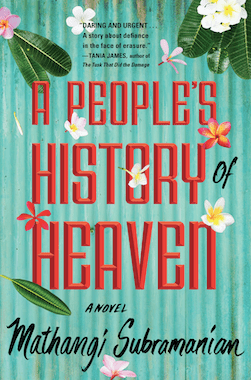Mathangi Subramanian Discusses Underrepresented Characters and Her Novel, A People’s History of Heaven

South Asian literature has a rich tradition of challenging Western conceptions about identity, post colonialism and feminism. But when author Mathangi Subramanian considered the landscape of literature depicting poverty in South Asian countries—particularly in India—she felt something was lacking.
“There’s this idea that there are certain stories that are more interesting to read or more realistic than other stories,” Subramanian tells Paste. “People tend to forget there are women living in these communities and that they have complex lives.”
Her debut novel for adults, A People’s History of Heaven, exists within those underrepresented spaces. An unspecified narrator tells the story of her community, a slum named Swargahalli. The community sign has broken, however, so it appears that the area is called Swarga, the Sanskrit word for “Heaven.” The narrator belongs to a tight-knit group of five friends: artistic and fatherless Banu, dance-obsessed and visually impaired Deepa, trans girl and class leader Joy, queer tomboy Rukshana, and immigrant Padma. The girls are students at a local school, where they help one another shoulder the burdens of being poor and marginalized within their community. But their most urgent concern is the imminent destruction of their slum; as bulldozers gather near their homes, the girls and their mothers stall the plans to tear down Heaven.
 The novel, which Subramanian wrote over the course of six years, was inspired by her own time in Bangalore. While researching early childhood education as a Fulbright Scholar, she got to know women and girls living in poverty.
The novel, which Subramanian wrote over the course of six years, was inspired by her own time in Bangalore. While researching early childhood education as a Fulbright Scholar, she got to know women and girls living in poverty.
“One of the reasons I wanted to write such a diverse cast of characters was that the diversity I found in Bangalore was surprising to me,” Subramanian says, “and I was embarrassed that I was surprised by it.”
Some of that surprise was rooted in the fact that, while her husband and family are from India, Subramanian had not spent a significant amount of time in the country prior to moving to Bangalore.
“I was so overwhelmed and confused and surprised by everything I was seeing in India,” Subramanian says. “Writing was about processing my emotions.”
Subramanian succeeds in developing three-dimensional characters; the girls are complex, while the adults in their lives become more layered as we learn about their work, education and efforts to build a sustainable life for their children. The mothers and their relationships to their daughters is especially fascinating, as they move at the periphery while offering flashes of their own ambitions.
The girls were originally the sole focus of the narrative, and Subramanian wrote the scenes highlighting the grown women shortly after adopting her own daughter. “Some of my favorite scenes in the book are the ones I wrote when I was really raw from not sleeping and getting my daughter to eat,” she says. “It was a powerful experience to write these mothers while I was learning how to be a mom.”
While the struggles women and girls in this particular community face are front and center, the heart of the narrative is the bond between the five friends. Finding that balance was important to Subramanian, who doesn’t share many of the identities of her characters.
“I was nervous to write some of these characters, because I’m able bodied, I’m straight, I’m not poor,” she says. “But it felt more dishonest to erase these characters in a space that is so actively erased by the Indian government. To be complicit in someone else’s erasure when I saw all these women felt more dishonest than trying to inhabit these characters.”
Erasure itself is a key element of the novel. Heaven is set for demolition, a throughline for the plot that echoes Subramanian’s own experiences in Bangalore. While there, she and her husband participated in efforts to save a slum from being torn down. Subramanian points out that across India, slum demolition is a significant problem facing communities with few resources; there are numerous Slum Clearance Boards in the country.
“The intention behind the office is not to support or to help these communities thrives,” she says.
But as Subramanian makes clear in the novel, it’s not only people in positions of power who are participating in the destruction. “[Workers carrying out the demolition] were the same class level as the people whose homes they were destroying,” she says. “There are the people who make the plans, and then there are the people who carry out the orders.”
Subramanian introduces one more facet to the exchanges between the workers and the residents of Heaven: a white woman with a camera, who doesn’t speak Hindi but arrives at the last minute to take pictures of the people who live there. The woman was inspired by a photographer whose work Subramanian saw and the disparity Subramanian felt between the community shown in that work and the one she saw in person. In the images, the women and children were seen weeping amid ruins.
“I went to the site, and people were upset,” Subramanian says. “But they were living their lives. What that photographer captured was so different from what I found there.”
The novel’s photographer isn’t merely a caricature of the outsider who dwells in the pain of others. The girls, noting that the woman isn’t getting the right shots, show her their home and try to help her understand what makes Heaven so special. “I sometimes feel like I was that character—this very well-intentioned Westerner who has no idea what is going on,” Subramanian says.
A People’s History of Heaven highlights its characters’ unique experiences and identities. Subramanian hopes that for others, and particularly for South Asian readers who are underrepresented in literature, the book serves as encouragement to build a unique space for themselves as well.
“Being from a developing country or living in poverty doesn’t mean you are less interesting or less complex,” Subramanian says. “There are so many ways to be South Asian.”
Bridey Heing is a freelance writer based in Washington, DC. More of her work can be found here.







































